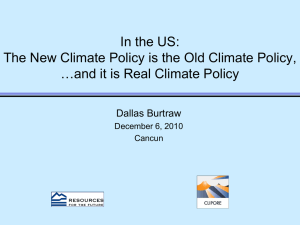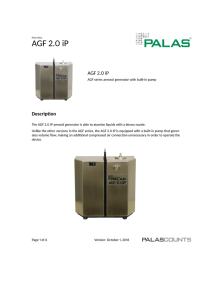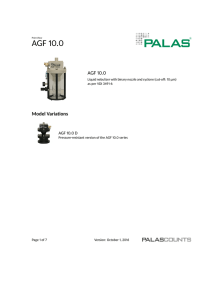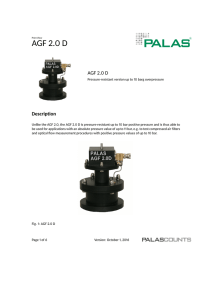Panel: UN High-Level Advisory Group on Climate Change Finance December 6, 2010 Cancún
advertisement
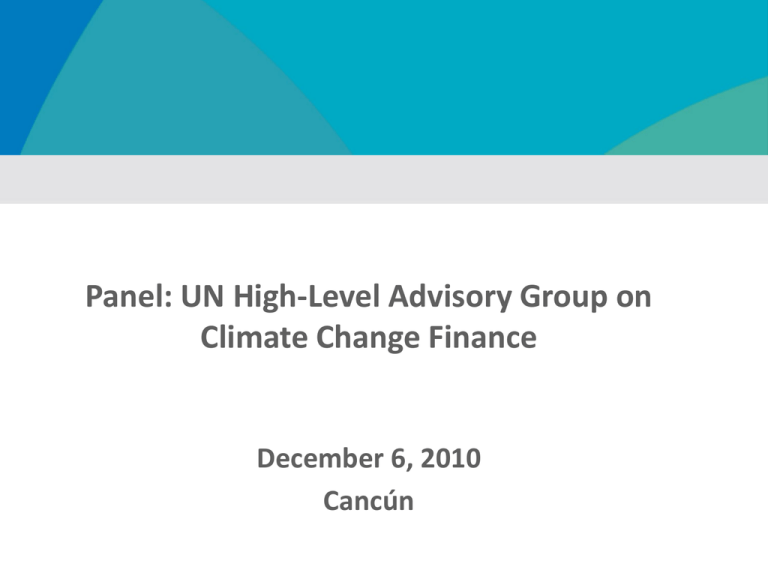
Secretaría de Hacienda y Crédito Público Panel: UN High-Level Advisory Group on Climate Change Finance December 6, 2010 Cancún Introduction • In December 2009 at the UN Climate Change Conference in Copenhagen, there were negotiated political agreements on finance: o Fast Start: Developed countries commitment to provide new and additional resources (US$30 billion, 2010-2012). o Long Term Financing: Developed countries commitment to a goal of mobilizing jointly US$100 billion dollars a year by 2020. • On February 2010 The Secretary-General of United Nations established a HighLevel Advisory Group on Climate Change Financing (AGF). • AGF identified a methodological framework to assess the different financing proposals from a variety of sources, including public and private, bilateral and multilateral, as well as innovative sources of finance. • AGF did not consider fast start financing, but as it is mentioned in the Report, some potential sources could be mobilized relatively fast. 2 Main conclusions from the Report o Meet the goal of US$100 billion per year by 2020 it is challenging but feasible. o Strong commitments to domestic mitigation in developed countries are key for mobilizing financing. o Key elements to reach the goal of US$100 billion: - The importance of new carbon-based public instruments; - A carbon price in the range of US$20-25 per tonne of CO2 o Private investment flows are crucial for the transition to a low-carbon economy. o A combination of resources (public and private) will be require to address climate actions. o Multilateral Development Banks and the United Nations have a key role in fostering low-carbon growth. o Carbon markets offer opportunities for supporting new technologies and leveraging private investment. 3 AGF: potential sources • Carbon Market Public Revenue: o Assigned Amount Units auctioning (AAU) o Emission Trading System auctioning (ETS) • International Transport: o Aviation Tax o Maritime Tax • Carbon related revenue: o Carbon Tax; o Removal fossil energy subsidies • Financial Transaction Tax • Direct budget contributions • Resources generated through MDBs current balance sheet headroom • Potential replenishments and paidin capital contributions by countries to MDBs Public Sources Carbon Market Development Bank Instrument Private Capital • Refers to transfers of resources related to purchases of offsets in developing countries. • Example: Clean Development Mechanism in Kyoto Protocol, CDM. • Flows of international private finance resulting from specific interventions by developed countries. The AGF report concluded that combination of resources will be require to effectively address climate actions, public, private, grants and loans would be necessary. 4 Deepening Carbon Markets Public Sources Carbon Market Development Bank Instrument Private Capital • The international negotiations to achieve a climate accord, face challenges, partially because the confrontation between developed and developing countries o Least developed countries (LDCs) have opposed commitments to reduce their emissions because this could delay their industrialization process • The same was thought of free-trade agreements 15 years ago. o After NAFTA, Mexico's biggest exports are cars and not raw materials. o Mexico is the world´s largest producer of smart-phones. • Since the signing of NAFTA, free trade agreements between developed and developing countries have become increasingly common. • In this context, integrated Carbon Emissions Markets would be economically and socially superior to a purely developing countries market. 5 Deepening Carbon Markets Public Sources Carbon Market Development Bank Instrument Private Capital • Two potential ways which developing countries could be integrated into developed Carbon Markets: 1) Integration via offsets 2) Formal link between Cap and Trades Integration via offsets • The two key steps that developing countries would need to follow to trade offsets with developed countries in a bilateral way would be: o Negotiate each sector’s baselines o Monitoring, Reporting and Verification (MRV). • Under this scheme, developing countries are not legally bound to reduce its emissions. • This could, nevertheless, be the first natural step towards carbon markets formally integrated between developed and developing countries 6 Deepening Carbon Markets Public Sources Carbon Market Development Bank Instrument Private Capital Formal Integration between Cap and Trades • The different cap and trade systems and legislative initiatives in the developed world establish the possibility (in the case where other countries establish cap and trade systems similar to theirs), to recognize permits as “international emission allowances” • This recognition would create in practice a unique carbon emissions market between all linked systems 7 Public Sources Public Sources Carbon Market Source Development Bank Instrument Private Capital Positive Other Information • Carbon price fluctuations • Maintain or create new trading system Assigned Amount Units (AAU) auctioning Emission Trading System (ETS) auctioning • Direct related to carbon emissions • No incidence on developing countries • Not all developed countries have an ETS • Challenging to implement • Requires international agreement on earmarking Bunker fuel (Maritime/Aviation Tax) • Direct related to externality • Practical to implement • Contribution from developing countries • Possible economic distortion if it is not applied universally. Financial Transaction Tax • Raise significant amounts • New and additional • Not direct related to carbon emissions 8 Accountability and Transparency • The report acknowledges that accountability and transparency is essential for building trust between developed and developing countries. • This is true in terms of mobilizing resources and spending them • The report does not specify methodology for a possible mechanism to monitor financing. It will be up to Parties to take a decision in this area. 9


